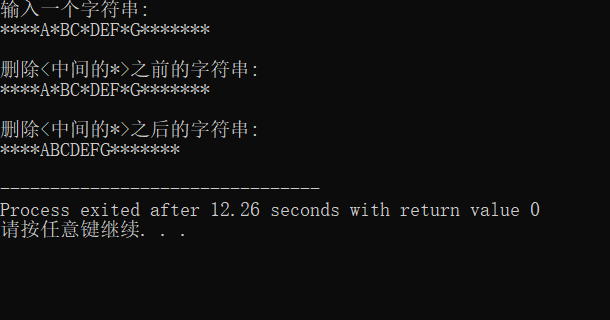实验五
实验五小结
二分查找
ex1-1.cpp
// 练习:使用二分查找,在一组有序元素中查找数据项 // 形参是数组,实参是数组名 #include <stdio.h> const int N=5; int binarySearch(int x[], int n, int item); int main() { int a[N]={1,3,9,16,21}; int i,index, key; printf("数组a中的数据:\n"); for(i=0;i<N;i++) printf("%d ",a[i]); printf("\n"); printf("输入待查找的数据项: "); scanf("%d", &key); // 调用函数binarySearch()在数组a中查找指定数据项item,并返回查找结果给index index = binarySearch(a, N, key);// 补足代码① // ××× if(index>=0) printf("%d在数组中,下标为%d\n", key, index); else printf("%d不在数组中\n", key); return 0; } //函数功能描述: //使用二分查找算法在数组x中查找特定值item,数组x大小为n // 如果找到,返回其下标 // 如果没找到,返回-1 int binarySearch(int x[], int n, int item) { int low, high, mid; low = 0; high = n-1; while(low <= high) { mid = (low+high)/2; if (item == x[mid]) return mid; else if(item<x[mid]) high = mid - 1; else low = mid + 1; } return -1; }
验证:
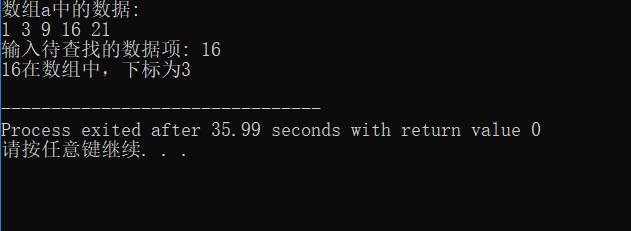

ex1-2.cpp
// 练习:使用二分查找,在一组有序元素中查找数据项 // 形参是指针变量,实参是数组名 #include <stdio.h> const int N=5; int binarySearch(int *x, int n, int item); int main() { int a[N]={1,3,9,16,21}; int i,index, key; printf("数组a中的数据:\n"); for(i=0;i<N;i++) printf("%d ",a[i]); printf("\n"); printf("输入待查找的数据项: "); scanf("%d", &key); // 调用函数binarySearch()在数组a中查找指定数据项item,并返回查找结果 // 补足代码① index = binarySearch( a,N,key) ; if(index>=0) printf("%d在数组中,下标为%d\n", key, index); else printf("%d不在数组中\n", key); return 0; } //函数功能描述: //使用二分查找算法在x指向的数据项开始的n个数据中,查找item // 如果找到,返回其位置 // 如果没找到,返回-1 int binarySearch(int *x, int n, int item) { int low, high, mid; low = 0; high = n-1; while(low <= high) { mid = (low+high)/2; if (item == *(x+mid)) return mid; else if(item<*(x+mid)) high = mid - 1; else low = mid + 1; } return -1; }
验证:
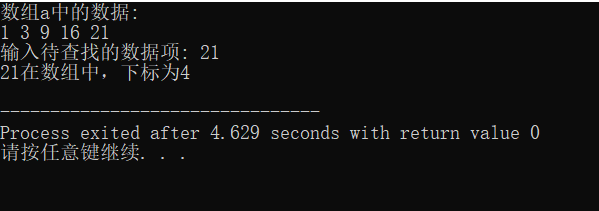
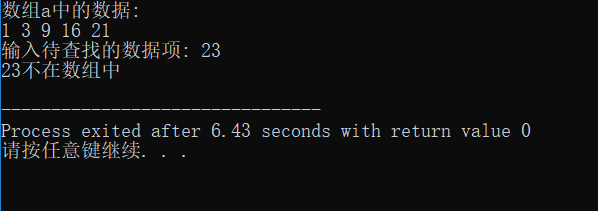
选择法排序:
ex2-2.cpp
// 练习:使用选择法对字符串按字典序排序 #include <stdio.h> #include <string.h> void selectSort(char str[][20], int n ); // 函数声明,形参str是二维数组名 int main() { char name[][20] = {"John", "Alex", "Joseph", "Candy", "Geoge"}; int i; printf("输出初始名单:\n"); for(i=0; i<5; i++) printf("%s\n", name[i]); selectSort(name, 5); // 调用选择法对name数组中的字符串排序 printf("按字典序输出名单:\n"); for(i=0; i<5; i++) printf("%s\n", name[i]); return 0; } // 函数定义 // 函数功能描述:使用选择法对二维数组str中的n个字符串按字典序排序 void selectSort(char str[][20], int n) { int i,j; char t[20]; for(i=0;i<n-1;i++) for(j=0;j<n-i-1;j++) { if(strcmp(str[j],str[j+1])>0) { strcpy(t,str[j]); strcpy(str[j],str[j+1]); strcpy(str[j+1],t); } } }
验证:
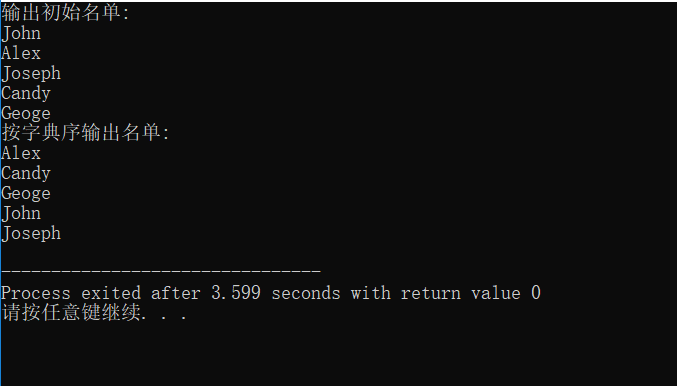
练习一:
// 用指针变量处理字符串练习1 // 删除前导* #include <stdio.h> void delPrefixStar(char []); // 函数声明(函数声明中可以省略数组名不写) int main() { char string[80]; printf("输入一个字符串:\n"); gets(string); printf("\n删除<前导*>之前的字符串:\n"); puts(string); delPrefixStar(string); // 调用函数,删除前导*; 注意实参的写法 printf("\n删除<前导*>之后的字符串:\n"); puts(string); return 0; } // 函数定义 // 函数功能描述 // 删除字符数组s中前导* void delPrefixStar(char s[]) { char *target, *source; // 从字符串开始找到不是*的位置 source = s; while(*source == '*') source++; // 从这个位置开始将余下的字符前移 target = s; while( *target++ = *source++); }
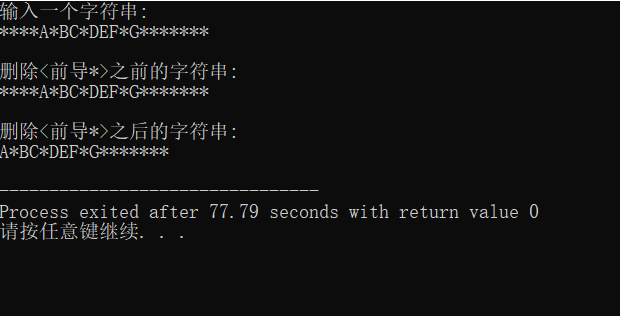
练习二:
// 用指针变量处理字符串练习2 // 删除中间和末尾的* (即除了前导*,删除字符串中其它全部*) #include <stdio.h> void delStarButPrefix(char []); // 函数声明(函数声明中可以省略数组名不写) int main() { char string[80]; printf("输入一个字符串:\n"); gets(string); printf("\n删除<中间和末尾的*>之前的字符串:\n"); puts(string); delStarButPrefix(string); // 调用函数,删除中间和末尾的*; 注意实参的写法 printf("\n删除<中间和末尾的*>之后的字符串:\n"); puts(string); return 0; } // 函数定义 // 函数功能描述 // 删除字符数组s中除了前导*以外的所有*(即删除字符串中间和末尾出现的*) void delStarButPrefix(char s[]) { int i=0; // i用于记录字符在字符数组s中的下标 char *p = s; // 跳过前导*,i记录字符在字符数组s中的下标,p记录首个非*字符的位置 while(*p && *p == '*') { p++; i++; } // 从p指向的字符开始,把遇到的*删除 while(*p) { if(*p != '*') { s[i] = *p; i++; } p++; } s[i] = '\0'; // 思考:这一步这样写的原因 }
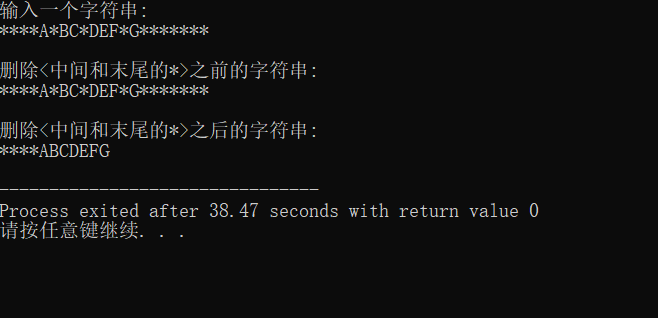
练习三:
// 用指针变量处理字符串练习3 // 删除字符串中间的* #include <stdio.h> void delMiddleStar(char []); // 函数声明(函数声明中可以省略数组名不写) int main() { char string[80]; printf("输入一个字符串:\n"); gets(string); printf("\n删除<中间的*>之前的字符串:\n"); puts(string); delMiddleStar(string); // 调用函数,删除字符串中间的*; 注意实参的写法 printf("\n删除<中间的*>之后的字符串:\n"); puts(string); return 0; } // 函数定义 // 函数功能描述 // 对字符数组s中存放的字符串,删除中间出现的* void delMiddleStar(char s[]) { int i=0; char *tail, *head, *p; // 找到末尾第一个非*字符的位置 tail = s; while(*tail) tail++; tail--; while(*tail == '*') tail--; // 找到开头第一个非*字符的位置 head = s; while(*head == '*') head++; // 把中间出现的*去掉 p = s; while(p<=head) { // 思考这里条件表达式为什么这样写,这个循环的功能? s[i] = *p; p++; i++; } while(p<tail) { if(*p != '*') { s[i] = *p; i++; } p++; } while(*p) { s[i] = *p; i++; p++; } s[i] = '\0'; // 思考这里为什么要这样做 }
